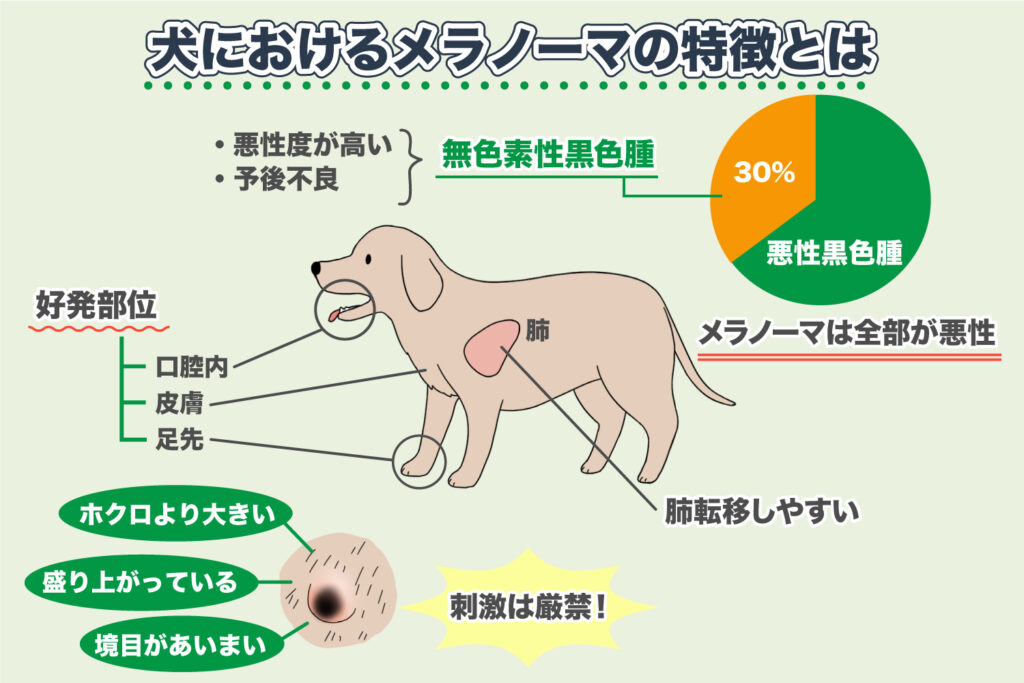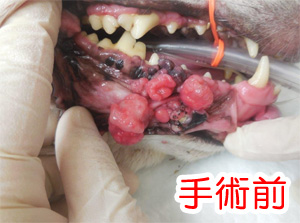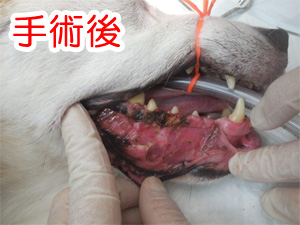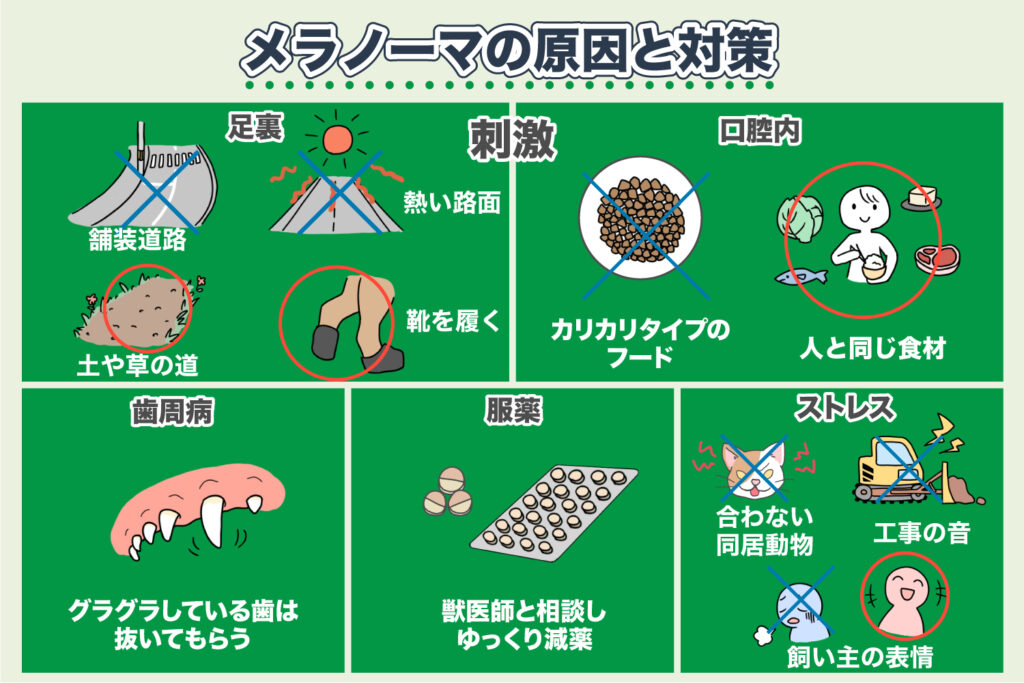Melanoma in dogs is an extremely aggressive cancer, also known as malignant melanoma. It often recurs shortly after surgery, and it typically responds poorly to chemotherapy. However, there is potential for long-term survival by properly boosting the immune system.
In fact, there have been numerous cases where managing the immune system with Cordy helped in controlling cancer in dogs.
This page summarizes the causes, symptoms, treatment methods, and tips for improvement and cure of melanoma.
We also introduce many cases of improvement. We hope this serves as a support and a beacon of hope for everyone.
目次
- 1 What is Melanoma in Dogs?
- 2 Characteristics of Melanoma in Dogs
- 3 Which dog breeds are prone to melanomas?
- 4 Methods of Examination and Diagnosis for Melanoma
- 5 General Treatment Methods for Melanoma
- 6 Alternative Therapies for Melanoma
- 7 Removing the Causes Worsening Melanoma
- 8 Immune Measures for Melanoma Improvement
- 9 Considerations for Everyone
What is Melanoma in Dogs?

Many people feel a sense of hopelessness when diagnosed by the veterinarian with “melanoma” or “malignant melanoma that has metastasized to the lungs”.
When a dog is diagnosed with melanoma, surgery, chemotherapy, and radiation are considered as treatment options.
Because it is a highly aggressive cancer, treatments can place a significant burden on the body, but recurrences in the short term or a lack of treatment efficacy are not uncommon.
by removing the underlying causes and providing a diet that suppresses melanoma,
strengthening the dog’s inherent immune system,
and paying close attention to how you care for your beloved dog,
we believe that you can significantly improve the prognosis and maintain the quality of life (QOL), restoring their energy and appetite.
By providing ingredients that are expected to improve immune function as a supplement to actual hospital treatment, there have been numerous instances where your pet dog’s vitality and appetite returned, bringing back smiles to everyone and allowing you to spend enjoyable times together. We encourage you to also refer to these examples.
- Lymph Node Metastasis of Oral Melanoma (Malignant Melanoma): A Case in a Miniature Dachshund
- Controlling Two-Month Prognosis Oral Melanoma in Dogs with Anti-Cancer Drugs and Cordy
- Cases of Long-Term Control of Canine Oral Melanoma without Chemotherapy
- Long-Term Control of Canine Oral Melanoma without Surgery
- Usage Example of Oral Melanoma Tumors in Dogs Reported by Shiota Animal Hospital
- Cases of Long-Term Control of Canine Oral Melanoma
- Cases of Controlling Canine Oral Melanoma with Alternative Therapies
Melanomas, commonly occurring in dogs, are a type of skin cancer also known as malignant melanoma.
They progress quickly, are highly invasive, and are prone to recurrence, lymph node metastasis, and lung metastasis after surgery, making them one of the most dangerous types of cancer.
In humans, the incidence rate is a few people in every 100,000, but in dogs, the rate is considerably higher.
So why is the incidence rate of melanoma in dogs so high? Let’s look at the causes of their occurrence.
Causes of Melanoma Occurrence
In the oral cavity, contributing factors include hard dog food, bone chews, and chew toys.
Around the paw pads, harsh walking routes, hot asphalt in summer, and other environmental factors may play a significant role.
Oral Melanoma often occurs in the gums, lips, tongue, and upper jaw.
They can particularly arise around the nails (nail bed) and at the transitional zones between skin and mucous membranes, with many of these cases having a high degree of malignancy, necessitating caution.
In humans, the cause is attributed to strong ultraviolet rays from the sun.
Short-haired breeds and dogs that have been given a summer cut may experience a slightly elevated risk.
Of course, the most significant cause is not these external factors mentioned above.
The problem lies within the body, specifically a decline in immune function (immune system disruption). When the immune system does not work properly, it cannot control the occurrence and growth of melanomas.
Characteristics of Melanoma in Dogs

Both originate from melanocytes that produce melanin pigment.
They often appear black due to pigment deposition, resulting in a darker color compared to surrounding tissue.
- Larger than a mole
- Raised
- Undefined borders
These symptoms should be watched carefully.
If a sudden, rapid growth is observed, **melanoma is suspected**, and you should have your pet examined by a veterinarian.
Melanomas are often dark (hence the name “malignant melanoma”), but about 30% of melanomas lack melanin and do not appear black.
Non-black melanomas are referred to as “amelanotic melanoma” or “hypomelanotic melanoma.”
#### What is Amelanotic Melanoma?
Typically, malignant melanomas are discovered as “black tumors,” but some melanomas do not contain pigment and appear not black. These are known as amelanotic melanomas.
Amelanotic melanomas are tumors formed from melanocytes that do not produce melanin. Compared to malignant melanomas, they are considered more aggressive and have a poorer prognosis.
Melanomas usually develop on the skin in contact with the outside environment, particularly in the mouth and on the feet, while it is rare for them to originate from internal organs.
When found in the lungs, it is almost always due to metastasis from another site.
Melanomas are generally considered to progress quickly, largely owing to the abundance of “cancer stem cells” which are believed to contribute to their rapid growth.
For more information about stem cells, the main driver behind cancer growth, refer to [Suppress Cancer Stem Cells and Overcome Pet Cancer](https://cordy-en.com/cancer-stem-cells/).
Avoid irritating melanomas as this can further accelerate their growth. Do not poke or press them strongly.
Excessive testing can also be a form of irritation, so it is advisable to avoid overly frequent examinations.
**Melanoma is a cancer that readily metastasizes to the lungs**.
In advanced melanoma, lung metastasis is commonly found.
If lung metastasis is detected, curing the cancer with conventional treatments becomes exceedingly difficult. It is crucial to develop a treatment plan aimed at coexistence.
### Early Symptoms and Detection of Melanoma

Melanoma typically has no noticeable symptoms in its initial stages. If there is pain, it usually indicates that the tumor has grown significantly and started bleeding, marking an advanced stage of the cancer.
Coughing and shortness of breath can occur, which are symptoms often seen when melanoma metastasizes to the lungs, again signaling an advanced stage of cancer.
If such noticeable symptoms are present, the condition is likely already advanced.
Early detection is crucial given the rapid progression and high malignancy of skin cancer (melanoma/malignant melanoma).
Detecting asymptomatic melanomas through changes in physical condition is difficult. However, since the mouth and the underside of the feet are common sites for melanoma in dogs, periodic checks of these areas can aid in early detection.
It is recommended that you regularly engage in physical contact with your dog, checking their mouth and the undersides of their paws. If you notice any abnormalities, please consult a veterinarian as soon as possible.
Many melanomas develop in areas that are visible to the naked eye. Since melanoma often appears darker in color compared to the surrounding area, you can use this as a clue for detection.
It is often mistaken for moles or spots, so please check for the following characteristics to distinguish it:
- Recently appeared on the gums or underside of the paws
- Color is mottled
- Shape is not round or oval
- Edges are unclear and it is gradually spreading into the surrounding area
Melanomas are often found during regular checkups or routine examinations.
They might also be discovered at a grooming salon. For early detection, it is advisable to choose experienced veterinarians or groomers.
Which dog breeds are prone to melanomas?

Breeds prone to oral melanoma
- Small-sized dogs
- Retrievers, such as Labrador Retrievers and Golden Retrievers
- Scottish Terriers
- Dachshunds
- Poodles
Oral melanoma can occur in dogs not listed here. If you find a suspicious tumor in your dog’s mouth, it is recommended to consult a specialist veterinarian.
Breeds prone to skin melanoma
- Chihuahuas
- Boxers
- Dobermans
- Boston Terriers
- Terrier breeds, such as Scottish Terriers and Irish Terriers
- Spaniel breeds, such as Cocker Spaniels and Springer Spaniels
Skin melanoma can also occur in dogs not listed here.
When a suspicious malignant tumor is observed in the oral cavity, it is necessary to suspect oral melanoma. Therefore, it is recommended to seek a consultation with a specialized veterinarian.
Methods of Examination and Diagnosis for Melanoma

When diagnosing melanoma, similar to other skin cancers, the veterinarian will first observe it with the naked eye.
If suspicious, a sample of the tumor—either whole or in part—will be collected for analysis.
The testing company will report on the likelihood of the melanoma.
While blood tests alone are challenging for detecting melanoma, they are conducted to check the overall condition of the body.
Visual Inspection – Examination and Diagnosis of Melanoma
In addition to oral melanoma, other types of oral cancers in dogs include oral squamous cell carcinoma and fibrosarcoma. Mast cell tumors can also occur on the skin, but melanoma, known as malignant melanoma, is characterized by black pigmentation.
However, attention is needed as there also exists “amelanotic melanoma” which lacks pigmentation.
Especially small breeds and Golden Retrievers have a high incidence rate of oral melanoma. If an abnormality is detected, fine-needle aspiration biopsy and histopathological examination are performed next.
Fine-Needle Aspiration Biopsy and Histopathological Examination – Examination and Diagnosis of Melanoma
Fine-needle aspiration biopsy, or cytology, involves inserting a needle into the suspicious area to collect cells for examination.
If lymph nodes are swollen, fine-needle aspiration biopsy is performed to check for the presence of tumor cells.
However, in cases of melanoma with poor melanin pigmentation, cytology can be challenging for diagnosis.
For an accurate diagnosis, a slightly larger tissue sample is taken for histopathological examination.
Examination for Lung Metastasis (Melanoma Tends to Metastasize to the Lungs)
To check for lung metastasis, X-ray examination is performed. Tumors around 1cm in size should be visible on an X-ray.
With a CT scan, it’s possible to detect even smaller tumors that may not be visible on an X-ray.
However, it cannot be determined from the image alone whether the shadow spotted is melanoma or not.
Additionally, even if melanoma is found, treatment may be difficult in many cases.
CT scans involve significantly higher radiation exposure than X-rays and carry the risks associated with general anesthesia, which can be a burden on the dog.
Moreover, the costs are often very high.
Therefore, if your vet recommends a CT scan, it’s advisable to confirm with them if the benefits truly outweigh the potential drawbacks.
The main benefit of undergoing a CT scan is that it helps determine whether treatment is meaningful. If there is lung metastasis, procedures such as jaw amputation or limb amputation would not result in a complete cure and would be unnecessary treatments. A CT scan might also provide a more accurate prognosis when compared to an X-ray examination.
Ultrasound examination (ultrasonography) is also a diagnostic method used to examine the interior of the body.
While ultrasound can be used to check for lymph node metastasis outside the lungs, it is not effective for detecting metastasis within the lungs due to the air-filled nature of the lungs.
General Treatment Methods for Melanoma
The most effective treatment method is surgery.
Although chemotherapy is sometimes performed for melanoma, it is a type of cancer that is very resistant to chemotherapeutic agents. Hence, surgery becomes an extremely important option if it is feasible.
Some facilities may also perform radiation therapy for melanoma, but due to its highly invasive nature that spreads extensively into surrounding tissues, a wide area must be irradiated.
Furthermore, melanoma tends to metastasize early, which limits the effectiveness of radiation therapy.
All treatments carry significant risks.
It is recommended to carefully consider both the advantages and disadvantages before choosing a treatment method.
Melanoma Treatment: Radical Surgery


For canine melanoma, radical surgery is typically aimed for.
Radical surgery, in brief, is surgery aimed at cure.
To thoroughly eliminate the risk of recurrence, the tumor and the surrounding areas are excised as broadly as possible.
Of course, there are limits to how much tissue can be excised (margin), so the specific surgeries are as follows.
- If it is an oral melanoma, excise the upper or lower jaw.
- Amputation surgery for melanoma occurring on the limb.
You might wonder if such extensive excision is really necessary, but the invasiveness of melanoma is immense.
Even with extensive surgery, it is very common to leave behind a small number of cancer cells, resulting in a significant number of cases where recurrences occur despite having undergone a curative surgery.
Thus, it should be viewed not as a surgery guaranteed to cure, but as a surgery aiming for the possibility of a cure.
However, it is undeniably true that the number of cancer cells is significantly reduced through curative surgery.
Even if recurrence occurs, it allows for a longer time until it does.
There is also a possibility that melanoma will not recur during the pet’s lifetime.
Hence, post-operative care is extremely important.
Immune function often declines considerably due to anesthesia during surgery.
If immune function can be quickly restored and the compromised immune system can be stabilized post-surgery, the risk of melanoma recurrence and metastasis can be greatly reduced.
Because of some drawbacks associated with curative surgery, not all pet owners choose it.
Please ensure to get enough information from your veterinarian to decide whether surgery is the best option for your pet.
- The dog’s appearance will be significantly altered.
- Possibility of reduced quality of life (QOL).
- Difficulty in walking due to limb amputation.
- Inability to eat normally due to jaw removal.
- If lung metastasis was missed, the surgery might be unnecessary.
Melanoma Treatment: Palliative Surgery
Palliative surgery is also called debulking surgery and involves removing only part of the tumor.
Since the surgery is performed with the premise of leaving cancer cells behind, it cannot achieve complete remission on its own. The goal is to temporarily alleviate the problems caused by the tumor.
For instance, it can address the following issues:
- The tumor obstructs eating or makes breathing difficult.
- Continuous anemia due to tumor bleeding.
- Foul odor due to a festering tumor.
Many people might have a negative perception of the term “palliative,” but that should not be the case.
Palliative surgery aims to improve QOL and ensure a better time for the owner and their beloved dog.
Tooth extraction can also be considered a form of palliative surgery. It may significantly slow the progression of oral melanoma.
Melanoma Treatment: Chemotherapy
In the treatment of melanoma with anticancer drugs (chemotherapy), platinum-based agents such as carboplatin and cisplatin are used.
- Strain on the kidneys
- Bone marrow suppression (decreased white blood cells and platelets)
- Nausea and vomiting
- Loss of appetite
- Hair loss
- Fatigue (lethargy)
- Liver function impairment
In medical management with carboplatin, the response rate is reported to be 28%, and the median survival time is 165 days (according to ‘Guidelines for Small Animal Oncology’).
There are veterinarians who often say, “Dogs don’t suffer much from the side effects of anticancer drugs.” However, unlike humans, dogs cannot express feelings like “I feel sick,” “I’m tired,” or “I have no appetite.”
Additionally, side effects such as bone marrow toxicity, liver function impairment, and kidney function impairment are difficult to detect just by appearance.
Therefore, if your dog shows a decrease in energy or appetite after undergoing anticancer treatment, you should suspect possible side effects.
Are Anticancer Drugs Effective for Melanoma?
As mentioned earlier, melanoma is a type of cancer with many “cancer stem cells.” Cancer stem cells show strong resistance to anticancer drugs.
Even if there is some response, the disadvantages (side effects) of anticancer drugs often outweigh the benefits.
I have received reports of dogs that were in good health passing away a few days after starting anticancer treatment.
To avoid such situations, it is recommended to thoroughly confirm the potential risks, whether there are no side effects, if the treatment could lead to a deterioration in condition, or if it might even hasten the pet’s end.
Dogs that are anemic, low in albumin, or have impaired liver or kidney function are at higher risk of severe side effects.
In such cases, a more cautious approach is advisable.
Please make sure to read the following article if anticancer treatment has been recommended for your pet.
Melanoma Treatment: Radiation Therapy
When melanoma has progressed to a location that is difficult to operate on, radiation therapy may be proposed.
For instance, if oral melanoma has widely infiltrated up to the eye area, surgery with sufficient margins is not possible.
Even in such cases, radiation therapy is still possible.
However, each radiation therapy session requires general anesthesia, and it is difficult to completely eradicate cancer cells with radiation therapy, so it is not considered a definitive treatment.
Additionally, it can damage normal tissues, often resulting in sequelae.
Since dogs cannot speak, it is difficult to tell, but dry mouth (reduced saliva production) and alterations in taste or smell are likely not uncommon.
By the way, human radiation therapy involves gradual radiation over tens of days. In contrast, dogs receive intense radiation in just a few sessions, which is why sequelae are more likely to occur.
Given these and other reasons, careful consideration is necessary when choosing radiation therapy.
- General anesthesia is required for each irradiation
- Exposure to radiation might accelerate the progression due to immune suppression
- It is quite expensive relative to its effectiveness
Treatment of Melanoma: Others
When active treatment as mentioned above cannot be carried out, drugs such as steroids and antibiotics may be used.
Steroids have anti-inflammatory effects, and by reducing inflammation caused by melanoma, tumor shrinkage can be expected.
They may also be used to boost appetite.
(This is not the primary effect of steroids, but a usage that utilizes their side effects.)
However, since steroids also have immunosuppressive effects, prolonged use can lower immunity, creating an environment where tumor cells can become more aggressive.
It is important to closely monitor any changes in health to ensure that the drawbacks (symptoms due to immunosuppression) do not outweigh the benefits (anti-inflammatory effects).
Antibiotics are used for infection prevention.
In the case of oral melanoma, bleeding from the tumor may be a concern.
When bleeding occurs, it indicates that the tumor is damaged. Since the mouth is filled with various bacteria, there is a risk of bacterial infection.
To prevent such bacterial infections, antibiotics may be prescribed. However, this can also disrupt the balance of gut bacteria, leading to diarrhea from deteriorating intestinal flora and reduced immunity.
When using antibiotics, it is recommended to take probiotics or oligofructose to help activate good bacteria and maintain the balance of the intestinal flora.
Like anticancer drugs, both steroids and antibiotics also burden the liver and kidneys.
It is important to regularly conduct blood tests to monitor changes in liver and kidney parameters.
Alternative Therapies for Melanoma
Alternative medicine is, as the name implies, treatments that serve as alternatives to conventional therapy.
Various treatments have been devised and are being implemented in some veterinary hospitals.
Many alternative therapies have a lower burden on dogs, allowing for the possibility of combining several treatments simultaneously.
The fact that there is less damage means that it is less selective regarding the stage and condition of the disease.
Alternative therapies can be implemented for the prevention of recurrence before and after surgery, for cases where surgery is not possible, and even for cases with lung metastases.
Oral melanoma and skin melanoma often recur after surgery and are cancers that are difficult to treat with anticancer drugs. However, there have been reports of controlling these conditions with alternative therapies.
We particularly recommend considering alternative therapies in the following situations:
- When complications are present, and conventional treatment poses high risks
- When aiming to coexist with cancer
- When prioritizing QOL (Quality of Life)
- Before a definitive diagnosis
- When the diagnostic results are unsatisfactory
The Kamo Animal Hospital in Hiroshima, which specializes in alternative therapies for cancer, has reported treatments for melanoma that skillfully combine alternative therapies.
These reports have been introduced in professional journals and published in English papers.
The alternative therapies combined by the doctor include the following:
- Thermal ablation of tumors using hyperthermia equipment
- Dendritic cell therapy
- Lupenone
- Specific species of cordyceps fungus culture
For more details, please refer here:
Improvement Case of Oral Melanoma in a Dog
There are few disadvantages to alternative therapies, but if we were to list them, they are as follows:
- Unlike surgery, treatment does not end in one session.
- It may not always be effective. (Same as conventional treatment)
- With compromised immune function due to treatments like chemotherapy, some alternative therapies can be difficult to administer.
- Ninety percent of veterinary clinics are unable to provide alternative therapies, so you may not always have a reliable clinic nearby.
- Because adoption rates are low, it can be difficult to find information on the internet or in books.
Diet Therapy for Melanoma
 The goal is to slow down the proliferation of cancer, build strength, and improve conditions such as anemia and albumin levels.
The goal is to slow down the proliferation of cancer, build strength, and improve conditions such as anemia and albumin levels.
Our company and some veterinary clinics place a significant emphasis on a nutritional approach as the basis of treatment.
The primary energy source for cancer is carbohydrates.
A diet that restricts carbohydrates as much as possible is of great significance from a scientific perspective.
There are almost no downsides, making it a worthwhile approach to try.
If your dog can accept it without stress, please give it a try.
If it seems too stressful, consider implementing it partially.
It might be manageable with adjustments in seasoning or food temperature.
Compared to the convenience of commercial dog food, this diet therapy requires more effort, but it is not fundamentally difficult.
Please consider it as part of the treatment and invest a bit of your time.
It will definitely not be in vain.
To reduce your effort as much as possible, we have collaborated with veterinary clinics to create a list of ingredients. Please take a look.
A Healthy Diet Even for Pets – Foods to Fight Cancer
Removing the Causes Worsening Melanoma

Unless this is removed, the effectiveness of any treatment will be reduced.
Please refer to the following causes and countermeasures of melanoma.
Stimulation to the Footpads – Cause of Melanoma
Try to avoid paved roads as much as possible and choose walking routes with soft soil or grass.
Of course, walks on hot pavement are strictly prohibited.
Concerns include not only the heat stimulus but also chemical substances that may leach from asphalt.
However, ideal walking routes are not available everywhere.
Consider having your dog wear shoes just for walks.
Oral Stimulation – Cause of Melanoma
If the melanoma is in the mouth, it is best to avoid dry kibble.
The irritation might cause the tumor to grow.
Soaking the food in hot water or switching to semi-moist types are options, but ideally, consider switching to human food ingredients.
Various types of chemicals in commercial dog food might also affect the worsening of melanoma.
These are added to prevent spoilage, mold, and infestation.
There might be chemicals added that are not allowed in human food, or they might be present in higher amounts than human standards allow.
Periodontal Disease – Cause of Melanoma
Inflammation caused by periodontal disease might be a chronic source of irritation.
Having a veterinarian extract teeth that are already loose would be a good idea.
If a tooth falls out when no one is around, there is a risk of significant bleeding.
Medications that Serve Little Purpose – Causes of Melanoma
All medications have toxic elements.
We often encounter cases where antibiotics are used over long periods, which raises concerns about the disruption of the normal bacterial balance in the oral cavity. This imbalance also affects intestinal bacteria, inevitably leading to a weakened immune system.
Long-term use of steroids also guarantees a weakened immune system. If the risks are minimal, consider reducing the dosage.
However, abrupt discontinuation of steroids can lead to deterioration in health, so tapering off slowly is recommended. Always inform the veterinarian if you are attempting to reduce medication.
Stress – Causes of Melanoma
Severe stress is a clear factor in lowering immunity. Given that immunity is crucial in cancer suppression, managing stress is essential.
If there are other animals in the household that do not get along, they should be separated. If there is noisy construction nearby, place your pet in a quiet room.
Owners’ stress can also be transmitted to their pets. A sad expression from the owner can be stressful, especially for loyal dogs. Approach them with a smile, as this is also an important part of treatment. Please do your best.
When implementing the strategies introduced on this page, ensure they do not cause stress for your dog. Sometimes it’s better to take things slowly rather than rushing them.
Immune Measures for Melanoma Improvement
Our company believes that immune measures are crucial when your dog suffers from melanoma.
- The cancer recurred after surgery
- Chemotherapy was ineffective and the cancer progressed
- It was said that nothing more could be done
Generally, melanoma is considered highly malignant with rapid progression, resulting in a poor prognosis.
However, Cordy, which has potential immune-modulating functions, might help in suppressing tumor growth and preventing recurrence.
- The melanoma recurred after surgery
- The dog became lethargic during chemotherapy
- Received a terminal prognosis due to melanoma
When your dog has melanoma, whether they undergo surgery, radiation therapy, or chemotherapy, implementing immune measures is crucial.
Considerations for Everyone
Melanoma is among the most malignant types of cancer. While curing any cancer completely is difficult, melanoma is particularly challenging.
Standard Western treatments are generally applied to melanoma, but the outcomes have not been very favorable. It’s not uncommon to find dogs where recurrence or lung metastasis is detected even after major surgery.
In Western treatments, the fundamental idea is to thoroughly eliminate cancer cells by removing them or killing them with strong toxins. While these treatments may reduce the size of tumors, they often overlook the overall health of the dog and the root causes of cancer. We must be careful not to cause irreversible damage by prioritizing treatment alone, akin to “missing the forest for the trees.”
The goal that pet owners should ideally aim for is not just to receive treatment but to maintain the QOL (quality of life) of their beloved dogs and increase enjoyable times with them. It is important to calmly and carefully consider whether the planned or ongoing treatment aligns with the desired outcome for both the owner and the dog.
Few pet owners will be satisfied seeing their dogs lose jaws or limbs and deteriorate physically due to chemotherapy, even if they feel they have done everything possible.
Please be cautious not to fall into the common pattern of “the tumor shrunk, but so did the spark of life.”
Even if your beloved dog or cat becomes ill, do not leave everything to the veterinary hospital. Instead, think with your family about how to spend quality time together.
There are many things pet owners can do beyond what is introduced on this page. For those who wish to take action for themselves, please do consult with us. Even if a prognosis has been given, there should still be things that can be done. Let’s think about it together.
At our laboratory, we continue to research whether administering Cordy can expedite immune recovery during periods of reduced immunity caused by surgery or chemotherapy.
Though we do not fully understand the extent of the response, there is at least a sufficient chance that appetite and vigor may return.
When using drugs like chemotherapy agents, steroids, or antibiotics, liver function decline is a concern. In such cases, combining the treatment with domestic SPF pig-derived placenta extract powder may help minimize liver damage.
Even for pets whose liver values have already deteriorated, there are numerous instances of liver improvement in about a month by taking domestic SPF pig-derived placenta extract powder.
Furthermore, melanomas often involve severe inflammation. Therefore, providing EPA/DHA krill oil extracted from Antarctic krill, which has anti-inflammatory properties, is deemed effective.
In our laboratory, we continue to study Cordy, which is expected to regulate the immune system, domestic SPF pig-derived placenta extract powder, which is expected to protect liver function, and krill oil, which is expected to have anti-inflammatory effects. If you have any questions, please contact us.
監修獣医師:林美彩 所属クリニック:chicoどうぶつ診療所

代替療法と西洋医学、両方の動物病院での勤務経験と多数のコルディの臨床経験をもつ。 モノリス在籍時には、一般的な動物医療(西洋医学)だけでは対応が困難な症例に対して多くの相談を受け、免疫の大切さを痛烈に実感する。
ペットたちの健康維持・改善のためには薬に頼った対処療法だけではなく、「普段の生活環境や食事を見直し、自宅でさまざまなケアを取り入れることで免疫力を維持し、病気にならない体づくりを目指していくことが大切である」という考えを提唱し普及活動に従事している。
所属:
- Lymph Node Metastasis of Oral Melanoma in a Miniature Dachshund
- Controlling Oral Melanoma in a Dog with a Two-Month Prognosis Using Chemotherapy and Cordy
- Case of Long-Term Control of Canine Oral Melanoma Without Chemotherapy
- Case of Long-Term Control of Canine Oral Melanoma Without Surgery
- Usage Example of Cordy for Oral Melanoma Tumor in Dogs – Report from Shiota Animal Hospital
- Case of Long-Term Control of Canine Oral Melanoma
- Case of Controlling Canine Oral Melanoma with Alternative Therapy






